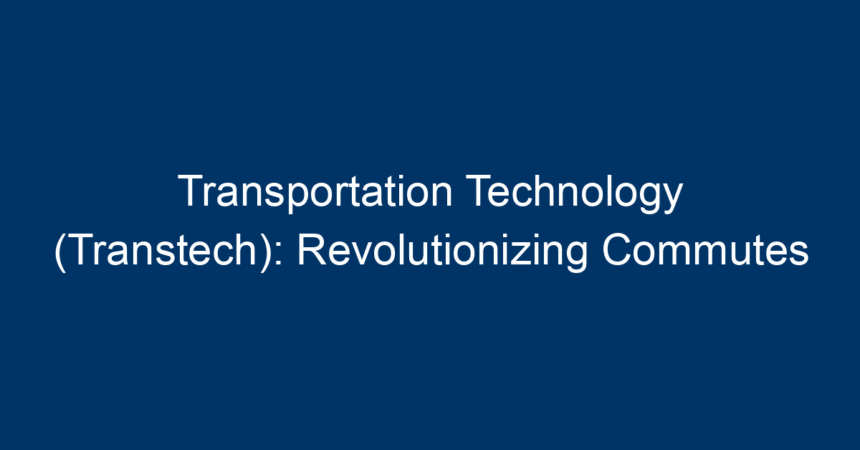The world is in the midst of a transformative era, and at the forefront of this change is transportation technology, colloquially referred to as transtech. With urban populations soaring and environmental concerns mounting, the way we commute is evolving rapidly. From electric vehicles to hyperloop systems, the advancements in transportation technology are not just innovations; they are reshaping our daily lives, making commutes safer, faster, and more efficient. This article delves into the various facets of transportation technology, exploring how it is revolutionizing commutes and the implications for our future.
The Current Landscape of Transportation
Understanding Traditional Transportation
Before diving into transtech innovations, it’s essential to grasp the current landscape of traditional transportation. Most urban environments rely heavily on cars, buses, and trains for daily commutes. These modes of transport often suffer from traffic congestion, high emissions, and limited accessibility, leading to a pressing need for a disruptive approach to commuting.
The Rise of Transtech
Fortunately, advancements in transportation technology (transtech) are paving the way for a more sustainable and efficient commuting experience. Innovations in this sector address not only the environmental impact but also enhance the overall efficiency of transportation systems.
Key Innovations in Transportation Technology
1. Electric Vehicles (EVs)
One of the most significant breakthroughs in transportation technology is the widespread adoption of electric vehicles (EVs). Unlike traditional gasoline-powered cars, EVs use electricity stored in batteries, resulting in zero emissions during operation.
Benefits of EVs
- Environmental Impact: By reducing reliance on fossil fuels, EVs contribute substantially to lowering greenhouse gas emissions.
- Cost Savings: Although the initial investment may be higher, the long-term operational costs of EVs are significantly lower than those of traditional vehicles.
2. Autonomous Vehicles
Self-driving cars represent another revolutionary aspect of transportation technology. These vehicles utilize sensors, cameras, and artificial intelligence to navigate without human input.
The Impact of Autonomous Vehicles
- Safety: With advanced safety systems, autonomous vehicles could drastically reduce the number of traffic accidents caused by human error.
- Accessibility: They promise to enhance mobility for individuals unable to drive, including the elderly and disabled.
3. Ridesharing and Mobility-as-a-Service (MaaS)
Platforms like Uber and Lyft illustrate how ridesharing is reshaping transportation. These services leverage smartphone apps to connect users with nearby drivers, offering a convenient alternative to traditional public transport.
Advantages of Ridesharing
- Reduced Traffic: By encouraging carpooling, ridesharing can alleviate traffic congestion in urban areas.
- Convenience: Users can access rides on-demand, enhancing the overall commuting experience.
The Role of Data in Transtech
Smart Transportation Systems
The integration of data analytics into transportation systems is creating smarter cities. Utilizing data collected from various sources, transportation authorities can optimize public transit schedules, manage traffic flows, and enhance safety measures.
Benefits of Smart Systems
- Efficiency: Improved traffic management can reduce delays during peak hours, making commutes quicker.
- Informed Decision-Making: Real-time data empowers city planners to make informed decisions regarding infrastructure development.
Internet of Things (IoT)
The IoT is increasingly playing a crucial role in transportation technology. Connected devices communicate with each other to provide real-time updates, improving overall efficiency.
Examples of IoT in Transportation
- Smart Traffic Lights: These adjust timings based on traffic conditions, reducing wait times at intersections.
- Connected Vehicles: Vehicles equipped with IoT devices can share information about road conditions, accidents, and other critical data with each other.
Sustainable Transportation Solutions
1. Public Transportation Innovations
Investing in cleaner public transportation solutions such as electric buses and trains is essential for reducing urban congestion and emissions.
The Benefits of Sustainable Public Transport
- Affordability: Public transport is generally more cost-effective for commuters compared to private vehicle use.
- Environmental Conservation: Moving larger numbers of people via buses and trains reduces individual car usage, cutting down on overall emissions.
2. Bicycle and Pedestrian Infrastructure
As urban areas evolve, they increasingly prioritize pedestrian-friendly and cyclist-friendly infrastructure. This shift encourages healthier commuting options.
Advantages of Cycling and Walking
- Health Benefits: Both cycling and walking promote physical health, reducing healthcare costs for individuals and communities.
- Reduced Emissions: More bikes on the road lead to fewer cars, directly contributing to a decrease in air pollution.
Challenges in Transportation Technology
While the future of transtech is bright, it is not without challenges. Some of the primary obstacles include:
1. Infrastructure Limitations
Many cities lack the necessary infrastructure to accommodate new technologies and innovations. Upgrading these systems requires significant investment and time.
2. Regulatory Hurdles
Transportation technology (transtech) often faces bureaucratic red tape. Striking a balance between innovation and regulation is essential to fostering an environment conducive to advancement.
3. Public Resistance
Despite the potential benefits, some individuals are resistant to adopting new technologies, often due to a lack of understanding or fear of change.
The Future of Transportation Technology
As we look ahead, the future of transportation technology (transtech) is replete with possibilities. Concepts like hyperloops, drone taxis, and advanced maglev trains are not just dreams; they are becoming realities through persistent research and development.
Global Collaborations and Innovations
Many countries are investing heavily in transportation tech R&D. Collaborations among governments, private companies, and academia are fueling innovation and leading to groundbreaking developments in mobility solutions.
Conclusion: Embracing the Future of Commutes
Transportation technology (transtech) is revolutionizing how we approach commutes, offering solutions that promise a more efficient and sustainable future. As cities around the globe continue to innovate, it’s essential for individuals, businesses, and governments to embrace these changes.
Actionable Insights
- Stay Informed: Subscribe to transportation technology newsletters and websites to keep abreast of the latest innovations.
- Advocate for Sustainable Practices: Support local initiatives aimed at promoting public transport and biking infrastructures.
- Embrace Change: Be open to trying new commuting options, including electric vehicles and ridesharing services.
By taking these steps, we can collectively contribute to a future where commuting is not only about reaching a destination but also about making choices that lead toward a greener and more connected world.




